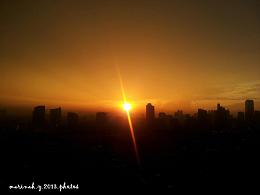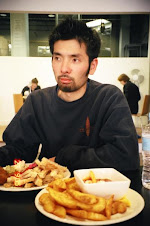In Koya-san
On my second day in Wakayama prefecture, I went to visit Koya-san. It was spring then but I did not come across any cherry blossoms there. They said the cherry blossoms in Koya-san appear about a month later than at the foot of the mountain. And so Koya-san was still wintry when I got there but I hadn���t expected it to be really cold at that time.
Not knowing it would be chilly on Koya-san, I remember deliberately leaving my jacket behind in the car before exploring the Okunoin. I guess I was thinking that the jacket would be useless during the walk and that bringing it around the cemetery would simply be a hassle. But I was wrong. It was especially cold in the Okunoin and I had ended up shivering the entire time I was in the graveyard.
To be honest though, the walk in the Okunoin wasn't very enjoyable to me as my thoughts was with my jacket throughout. Stupid I know but I didn���t bother go back to the car to get the jacket either all because the graveyard was damn massive and I was by then deep in the forested cemetery already! Read on...
1. Orientation
Sitting at the passenger rear seat alone as Kotaro drove the 4WD gave me opportunities to see the views from the windscreen and the two side windows of the car clearly. Having been used to seeing mountains in my stay in Tasmania, I found out that as much as the mountain sceneries in Wakayama appeared typical, there were still some undefined differences in the mountains in Japan and this was certainly refreshing to me.
The drive up Koya-san was scenic no doubt. The mountain scenery, as I have mentioned above, was spectacular all through. Yet the journey was still somewhat daunting. The winding highway and its many sharp bends had caused continuous change of gear between accelerating and breaking of the car, and therefore frequent jerking of the vehicle, which had consequently made me feel sick and many times during the mountain drive had I felt like vomiting. But I survived.
During the mountain drive, I remember I could hardly imagine what Koya-san would be like as the surrounding area on the highway was very densely bordered by forest scarps. Despite the vast information I had gathered from my previous readings, the area surrounding the highway had left me thinking that Koya-san would be a place so forested and steep and that its tourists would have to clamber to see a pagoda placed so high up the mountain.
But the Koya-san that I arrived at was surprisingly an irregular plateau, placed in the heart of a deep mountain, and somehow quite well traversed by travelers (and therefore ���civilized���). It was also massive in land area and even bus services were made available for visitors to move from one part of Koya-san to another.
2. What is Koya-san?Well, for those who do not know it yet, Koya-san is a mountain of about 2800 feet above sea level. Other than its designation as a World Heritage Site, it is, as mentioned in farstrider.net, famous for three things: its concentrated Buddhist community, the 110 active temples there, and its vast graveyard.
 In Koya-san, I found not only sacred sites and pilgrim routes, but also buildings of temples, lodgings as well as souvenir shops distributed all through.
In Koya-san, I found not only sacred sites and pilgrim routes, but also buildings of temples, lodgings as well as souvenir shops distributed all through. The weather was fine when we arrived in Koya-san, and Koya-san seemed alive with big tour buses and abundant international tourists traveling around, perhaps the most number of foreigners I had seen in an area since my arrival in the country.
Seeing those international tourists however had made me wonder how long it took everyone else to get to Koya-san because it took us about two hours on the road to finally arrive at the site from our starting point at Tanabe in Wakayama.
3. Spending my time in Koya-san
In Koya-san, Kotaro, Kenji and I did only three things whilst we were there; we had lunch, visited the Okunoin Cemetery and checked out Kongobuji. Actually there were a lot more things to see and do than just the above-mentioned three in Koya-san but we did not have ���that��� much time to check out many things then. Not only was Koya-san really vast and needed time to explore even if it meant only a temple, but also, we were tired from both the checking out of places as well as the mountain-drive. So we stopped in at only two places and had lunch whilst we were there. Quite a waste I know but I guess we���re alright with it nonetheless.
3.1 Lunch
Our first stop at Koya-san was lunch at a Japanese restaurant. Kotaro, Kenji and I settled on a restaurant that was close to the Information Office. We didn���t bother look farther for restaurants because most eateries over there were rather expensive (we knew this after looking at a couple of cafes in the building) and some of the restaurants were even closed. So there was not much of a choice to even start with actually.
The restaurant that we were at served reasonable priced dish. My set meal cost about ��1050 (S$13.45), and that was apparently the most expensive meal amongst ours three. To add to that fact however, I didn���t finish my meal in the end but was saved by Kenji who ate up the rest for me. Oh, and my set meal was actually my first ever soba noodle, so that perhaps explains why I couldn���t finish it (I've never eaten a cold noodle dish in the entire of my life before!!).
3.2 The Okunoin Cemetery
After lunch, we spent the entire noon checking out The Okunoin Cemetery. The cemetery was just behind the restaurant so we didn't have to drive there. Well, you may be wondering why go visit a cemetery when neither of us had anyone we knew buried there. You see, the thing is, the Okunoin Cemetery in Koya-san is a prominent site. Buddhist pilgrims in Koya-san went there for religious purposes but we went there simply to check Japan���s biggest graveyard and very important place in Mount Koya out.
Like other cemeteries, the Okunoin cemetery had many tombs, graves and statues. It is said that people from all over Japan, who wished to be buried close to Kobo Daishi (the founder of Shingon Buddhism), lie there, including former feudal lords, politicians and other prominent personalities. Their graves line the approaches to Okunoin for several hundred meters through the forest. One monument that I saw was a kind of grave built to commemorate Japanese, Malay and Australian soldiers killed in the World War II in North Borneo.
3.3 Kongobuji
Our next stop was Kongobuji. Kongobuji was about 2km away from the entrance of Okunoin, so instead of walking there we went there by car. Kongobuji is the headquarters of the Shingon school and the residence of Koya-san's abbot. In Kongobuji we saw rooms with pretty screen paintings and a rock garden that looked like those you would probably have seen in Kyoto. Towards the end of our visit in Kongobuji though, we were invited to have tea and rice cakes in a hall (servings included in admission fee actually) where a monk working there was giving a live sermon.
4. Thoughts on Koya-san
In all, I thought Koya-san was pretty alright. It's a whole new discovery to me and the sights were quite captivating. But I guess I wouldn't go there for a second time because the journey to and from Koya-san was too long and winding.
*Still working on the post's references.*
References:
Data on Koyasan, The Story of Koyasan, Available [Online]: http://www.asunam.com/koyasan_page.htm
Koya-san Part III: The Cemetery, Welcome to Koya-san! Available [Online]: http://farstrider.net/Japan/Koyasan/Cemetery1.htm
Mount K��ya, Mount K��ya - Wikipedia, the free encyclopedia, Available [Online]: http://en.wikipedia.org/wiki/Mount_Koya
Okunoin, Koyasan Travel: Okunoin, Available [Online]: http://www.japan-guide.com/e/e4901.html
Sacred Sites and Pilgrimage Routes in the Kii Mountain Range, Available [Online]: http://whc.unesco.org/en/list/1142












No comments:
Post a Comment